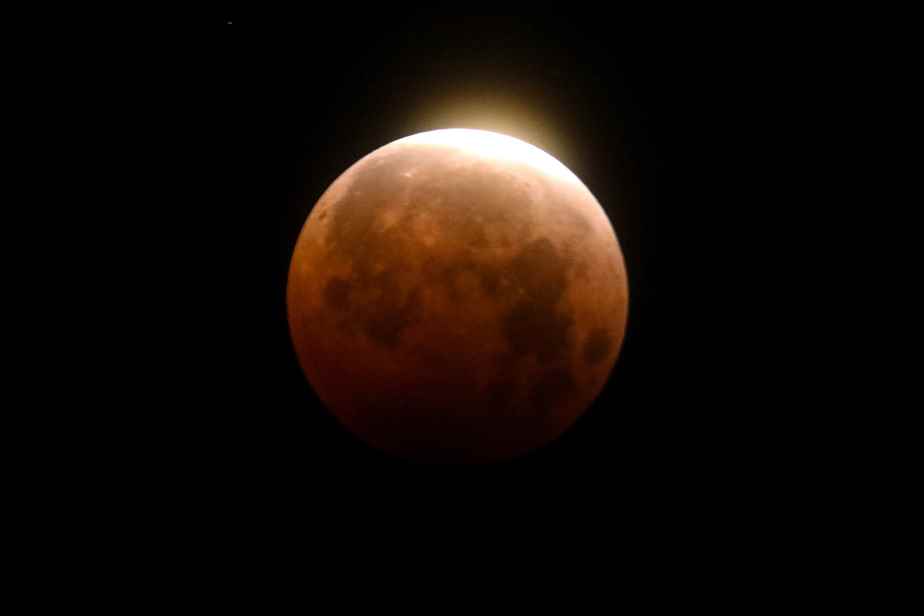At night, all cats are grey, as the saying goes. But that’s not always the case with the Moon, which will turn blood orange this Sunday during an 84-minute total lunar eclipse.
Posted at 6:00 a.m.
Quebecers are perfectly placed to admire the show from A to Z this year. A chance that will not be offered to them again for three years, says astronomer André Grandchamps, curator of the meteorite collection at the Planétarium Rio Tinto Alcan in Montreal. However, we must hope that the clouds do not come to hide the painting.
“It’s a fairly rare phenomenon and one of the most beautiful that can be observed,” rejoices Mr. Grandchamps.

PHOTO MARTIN CHAMBERLAND, THE PRESS
Astronomer André Grandchamps, curator of the Rio Tinto Alcan Planetarium meteorite collection
For a total eclipse to occur, the Moon must be full and the Earth must completely shield the Sun. Which only happens when the three stars are perfectly aligned, with the Earth in the middle.
Unlike solar eclipses, lunar eclipses can be viewed unfiltered across an entire hemisphere, says the astronomer.
The show will start late in the West and daybreak will shorten it in Europe, but not in Quebec, where we will attend the five acts.
If the rain or very dense clouds hide the sky, we will have to hope to recover on March 14, 2025.
Here’s what to watch and when
At 9:32 p.m. – first act – eclipse by penumbra – 55 minutes
The Moon then enters the area of penumbra which borders the shadow zone projected by the Earth. At this point, our satellite remains grey. To perceive that its luminosity is weakening is almost impossible, since it still receives solar rays, indicates Mr. Grandchamps. “But it can be seen by comparing two photos,” he says.
At 10:27 p.m. – second act – partial eclipse – 61 minutes
The Moon is slowly penetrating the Earth’s shadow cone. Even with the naked eye, the darkness can easily be seen nibbling at its surface, spreading from left to right as the rounded profile of our planet gains ground. The illuminated part of the Moon thus takes the form of a crescent, which becomes thinner and thinner.
Ancient peoples – like the Egyptians, Mayans, Incas and Chinese of another era – apparently believed that a sow, a jaguar, a three-legged toad or a demon swallowed the Moon during eclipses.
At 11:28 p.m. – third act and highlight of the show – total eclipse – 84 minutes
The Moon finds itself completely swallowed up by the shadow of the Earth and becomes much less bright, which allows the appearance of stars usually masked by its strong light.
At this point, the Moon changes color (find out why below). Rust, brick red… The color it takes on is never exactly the same from one eclipse to another.
It all depends on its height, trajectory and air pollution, among other things.
This time, André Grandchamps expects “a beautiful bright red”, since the Moon will brush against the heart of the shadow cone projected by the Earth.
At the peak of the eclipse, at 12:11 a.m. sharp, the hue will become particularly pronounced.
At 12:54 a.m. – fourth act – reverse partial eclipse – 61 minutes
The Moon will begin to move out of the Earth’s shadow. Its darkened portion will still be draped in red, but will appear black to us, in contrast to the neighboring portion, which will again become bathed in sunlight.
At 1:55 a.m. – fifth act – eclipse by inverted penumbra – 56 minutes
The Moon is again entirely in penumbra rather than in shadow and turns gray again.
Why does the Moon appear red to us during total eclipses?
When the Earth shields the Sun, its light can no longer reach the Moon without passing through our atmosphere. When they penetrate this gaseous layer, the solar rays – which carry all the hues of the rainbow – deflect in different directions, depending on their wavelengths. Purple, blue, green or yellow waves – shorter – scatter strongly in the wrong direction. While the red or orange waves – longer – partly reach the Moon, where they are reflected. This is what makes it go from a grayish white to a more or less intense red. The same phenomenon – called refraction – explains the color of sunsets.
Learn more
-
- 1km/second
- Approximate speed at which the Moon passes through the shadow cast by the Earth
Montreal Planetarium
- 2 or more
- Annual number of lunar eclipses, all types combined
Montreal Planetarium

